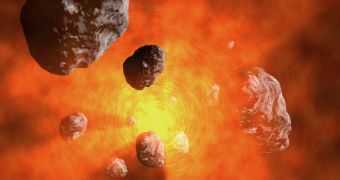A cosmic impact between two bodies resulted in a 200 mile-wide iron meteorite, the size of Lake Mead, behind Hoover Dam, left to chill out in space, and which produced roughly 60 smaller ones.
It is believed that asteroidal bodies are just leftover debris from the collisions and subsequent melting that happens when planets form. Scientists find that these leftover chunks typically have a dense iron core containing nickel, surrounded by an insulating layer of silicate. Evidence has suggested that the iron-nickel core cools relatively evenly, thanks to the insulating silicate mantle.
Calculating the cooling rates for the 60-odd meteorites that are known as the IVA iron meteorites (believed to have come from a single parent asteroid), Jijin Yang and Joseph Goldstein of the UMass Amherst department of mechanical and industrial engineering, and Edward Scott of the Hawaii Institute of Geophysics and Planetology at the University of Hawaii at Manoa, have gotten wildly different numbers. "We find that these cooling rates of the IVA irons vary by a factor of more than 50 and directly with the nickel content of the iron meteorite," Goldstein says. "This means there's something goofy happening."
Cooling rates of the IVA irons should have been very similar, so they re-calculated cooling rates for 10 IVA irons and combined the data with computer model simulations. They also examined the microstructure of several irons using a transmission electron microscope.
The conclusion was that the IVA meteorites must have cooled as one, big chunk, roughly 200 miles-wide and without an insulating mantle, and not in the form of a smaller insulated body as had previously been thought. If correct, the parent asteroid would have been comparable in size to the largest M class asteroid, 6 Psyche, says the research team.
"You can see the same phenomenon occurring when cooling steel," explains Goldstein. "If you take a new piece of steel out of a huge blast furnace and set it down, we know that the outside cools a lot faster than the inside because there's no insulation. The same would be true of the IVA irons in a metallic asteroid."
Since all the 60 or so meteorites recovered from around the world have the chemical makeup of the IVA irons, this suggests that they were all part of one metallic asteroid that broke up about 450 million years ago and then fell to earth in pieces.
Their final conclusion was that the parent asteroid must have formed after two protoplanets sideswiped each other, thus breaking off many different pieces with varying amounts of silicate. The authors believe that the metal containing the IVA irons was one of these pieces that contained little or no silicate insulation.

 14 DAY TRIAL //
14 DAY TRIAL //